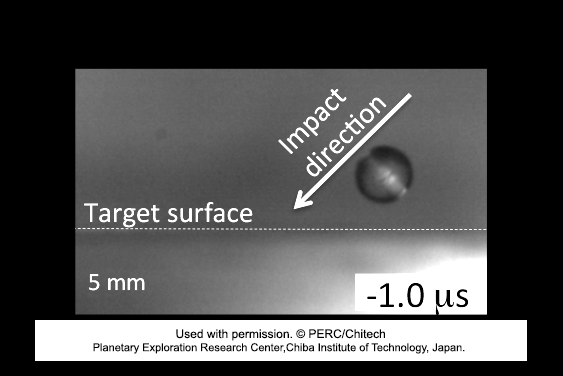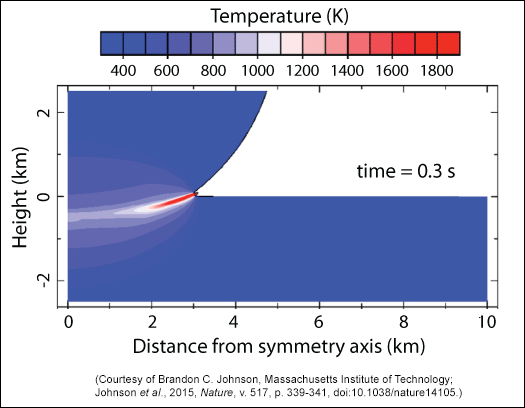Citation: Taylor, G. J. (April, 2015) Ancient Jets of Fiery Rain, PSRD, http://www.psrd.hawaii.edu/April15/impact-jetting.html.
 |
April 10, 2015
Ancient Jets of Fiery Rain
--- A new idea suggests that chondrules could have formed as the result of impact jetting caused when large planetesimals collided during planet formation.
Written by G. Jeffrey Taylor
Hawai'i Institute of Geophysics and Planetology
Chondrules are intriguing millimeter-sized crystallized droplets that are abundant in chondrites, so named because of the presence of numerous chondrules. They have puzzled cosmochemists since they were described by English scientist H. C. Sorby in 1877. Everyone agrees that they formed as molten droplets of silicates, but nobody agrees on how the little things formed. Ideas range from impacts onto asteroids, primary condensation in the solar nebula, shock waves and/or lightning in the solar nebula, or by processes operating as planets began to form. A new twist on this last idea was investigated in a new way by Brandon Johnson (Massachusetts Institute of Technology, MIT) and co-authors David Minton and Jay Melosh (Purdue University), and Maria Zuber at MIT. Johnson and coworkers modeled the effects of impacts between planetesimals 100–1000 kilometers in diameter. When such objects hit each other, the first thing that happens is jetting of molten rock. Johnson and colleagues propose that the jets will subdivide into droplets as the jetted material is shot into space. They estimate that the chondrules would have the correct cooling rates (as determined from previous studies of chondrules) and the collision frequency would be high enough to produce abundant chondrules. Johnson and coworkers suggest that chondrules are a "byproduct of [planetary] accretion."
Reference:
- Johnson, B. C., Minton, D. A., Melosh, H. J., and Zuber, M. T. (2015) Impact Jetting as the Origin of Chondrules, Nature, v. 517, p. 339-341, doi:10.1038/nature14105. [ abstract ]
- PSRDpresents: Ancient Jets of Fiery Rain--Short Slide Summary (with accompanying notes).
Facts About Chondrules
Cosmochemists know a lot about chondrules, including their compositions, cooling rates, textures (mineral shapes and intergrowths), sizes, abundances, isotopic compositions of oxygen and other elements, and ages. Here's a quick summary of the properties that models for the origins of chondrules must produce.
Size matters: Chondrules are usually described as "millimeter-sized" objects in chondrites. This is not really much of a simplification. Most of the little round things have diameters of 0.5–1.5 millimeters, although the mean size varies a bit among different types of chondrites. A small percentage of individual chondrules are as large as 5 millimeters. Some are as small as a micron. Most models, including the one by Brandon Johnson, focus on the abundant millimeter-sized chondrules.
Cooling rates: A series of thorough experimental studies of chondrule crystallization (see summary by Roger Hewins and colleagues published in 2005) show that the little droplets cooled at rates ranging from 5–3000 Kelvin per hour (about 40–5500 oF/hour). For comparison, a molten sphere in free space, cooling only by radiating its heat into cold space, would cool a thousand times faster than the upper range of the experiments. For the inferred slow cooling rates, the chondrules cannot be radiating into empty space, hence they formed in a cloud of hot dust and/or abundant other hot chondrules. The textures (crystal intergrowths), crystal sizes, and chemical zoning in mineral grains in the experimental runs match those found in natural chondrules. Models for the formation of chondrules need to depict an environment where chondrules form as slowly as the experiments reveal.
Chondrule Ages: Chondrules are old, dating to the very earliest days of the Solar System. (So old, in fact, that the concept of days is not relevant because the Earth had not yet formed!) As described in PSRD article: Dating Transient Heating Events in the Solar Protoplanetary Disk, amazingly precise ages have been determined for chondrules. The first objects to form were calcium-aluminum-rich inclusions (CAIs), which formed (most by melting, like chondrules) 4567.30 ± 0.016 million years ago. Only a few chondrules have been dated so precisely, but the ages indicate that chondrules formation began when CAIs formed and continued for three million years (see plot below). The chondrules-forming process needs to have operated over this entire time scale.
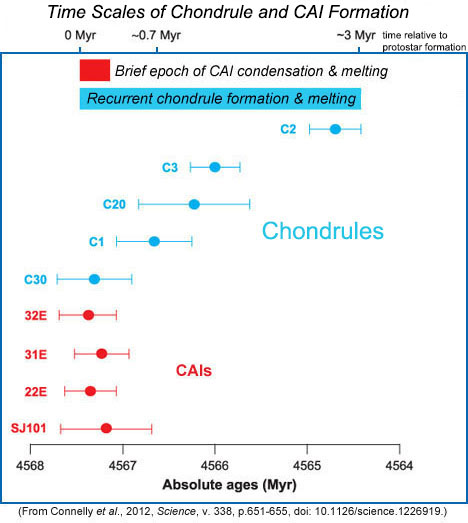 |
| Ages of CAIs and chondrules determined by high-precision lead-lead (Pb-Pb) dating. Error bars show the uncertainties in individual measurements. The average age of the CAIs is 4567.30 ± 0.16 million years, which suggests a time interval of only 160,000 years (0.16 million years) for formation of CAIs in CV chondrites. Equally important, one of the chondrule ages falls in the narrow range of ages of the CAIs, 4567.32 ± 0.42 million years. Other chondrules are younger, down to 4564.71 ± 0.30 (2.6 million years younger than CAIs). |
Chondrule compositions: Chondrules vary widely in chemical composition. They do not vary as widely as do rocks on Earth and other differentiated objects, but still widely enough to require that hypotheses for the origins of chondrules need to be able to explain the diverse chemical characteristics. An example of the large range in the compositions of chondrules is shown in the graph below, which is based on data from four different chondrites. Another important (and amazing) feature is that any given chondrite contains essentially the full range of chondrule compositions shown in the graph. How this compositional diversity arose is anyone's guess, and a quick read of articles about chondrules shows that guesses abound.
Chrondrule abundances: Chondrites are chock-full of chondrules (see image below), so whatever made them was efficient, or aided by a second process that concentrated them into chondrites. To be more quantitative about it, Lon Hood (University of Arizona) and Stu Weidenschilling (Planetary Sciences Institute, Tucson) calculated in a 2012 paper that whatever mechanism formed chondrules, it had to make a mass 3 to 30 times the current mass of asteroids in the main belt. This estimate takes into account efficiencies in accretion, subsequent melting of asteroids, and other processes.
 |
This photomicrograph of a thin slice of the Semarkona meteorite [Data link from the Meteoritical Bulletin ] reveals the abundant chondrules in this chondrite. |
Numerous Disparate Ideas for How Chondrules Formed
You'd think with all this quantitative information that we would have figured out how chondrules formed, but that's what makes the little frozen droplets of fiery rain (as H. C. Sorby called them in 1877) so fascinating. It sometimes appears that there are as many ideas for how chondrules formed as there are chondrules.
For a long time meteoriticists thought that chondrules were secondary objects formed by impact onto asteroidal or moon-sized objects. Discarding the impact idea took a while. Its demise was helped along by a paper I wrote with my colleagues Klaus Keil and Ed Scott in which we cited problems with chondrule abundances, the lack of other impact products, the absence of pre-chondrule target rocks, the presence of rims around chondrules, and the fact that impacts tend to smash and break rather than melt (well over 90% of the rock affected by an impact is fragmented, not melted). We gave the 1983 paper the New Age sounding title "Cosmic Setting for Chondrule Formation," but it did not discuss Gaia, the spirituality of chondrites, metaphysical implications, or Aquarius, and it did not have Deepak Chopra as a co-author. It might have mentioned crystals, but not their healing powers. The impact idea we helped kill involved relatively small impacts onto small bodies.
Impacts between molten objects has had some proponents. Such objects must have existed in the early Solar System, as shown by the existence of iron meteorites. Core formation requires substantial melting of an entire body in order for metallic iron to sink. The metallic magmas that gave rise to iron meteorites have melting temperatures that are so high that the associated rocky regions in the parent asteroids would have been at least half melted. A collision between two molten objects would have produced a string of molten blobs, though not necessarily chondrule-sized. It is also not clear that the blobs would have the range of chemical compositions shown by chondrules.
The idea that chondrules are primary objects sprung from a paradigm-shifting paper by John Wood in 1963, in which he suggested that chondrules are primary nebular products that formed from a hot solar nebula. This led to the idea that chondrules might have been the building blocks of the planets. The melting process was thought to be powered by either lightning discharges or shock waves in the dust/gas cloud surrounding the proto-Sun. Lightning is possible in the dusty solar nebula as dust motions can separate charges, leading to discharges. Shock waves could be generated in a number of ways, such as those caused by materials accreting to the protosolar disk or motions of planetesimals and planet-sized objects. There have even been suggestions that large shock waves were generated by the close passage of another star, an idea not as unlikely as it seems because the Sun formed in a region of the galaxy undergoing lots of star formation.
Most of the nebula shock wave ideas require the formation of millimeter- to centimeter-sized dust balls in the protosolar disk. (To picture the dust balls, think of dust bunnies under your bed.) Many models for chondrule formation by shock waves need large planetesimals plowing through the solar nebula, sending out bow waves that compressed and melted the dust balls. If the resulting chondrule cloud contained the right density of chondrules, the cooling rate could be right. Whether the dust balls varied sufficiently in composition is another question. The process can produce lots of chondrules, at least in principle.
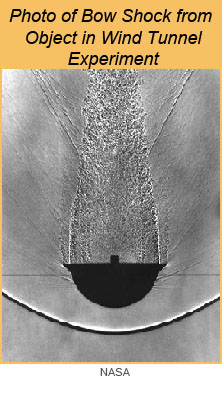 |
This photo shows the shock wave created in front of a blunt object (moving from top to bottom) as it plowed through air in a wind tunnel during an experiment at NASA Ames Research Center. This is one way shock waves might have compressed and heated the gas and dust in the solar nebula, perhaps simulating a large planetesimal moving in the early Solar System, before the nebular gas was lost. (PSRD has shown the picture before, but can never resist the opportunity to show it again. All waves are excellent natural phenomena; shock waves are particularly cool.) |
One particularly interesting idea for chondrule formation was proposed by Melissa Morris and Steve Desch (Arizona State University). They noted that hafnium-tungsten isotopic data from Martian meteorites indicated that a metallic core in Mars formed within 3 million years of the formation of the Solar System (see PSRD article: Festival on the Formation of the First Solids in the Solar System). This led them to propose that a Mars-sized object (perhaps even Mars itself) became a chondrule-manufacturing device as it and its bow wave plowed through the early Solar System. If correct, chondrule formation is part and parcel of planet formation.
As explained above, impacts of smaller objects onto relatively small ones are not particularly efficient at producing chondrules. However, impacts between large objects are still in the running, which is the subject of Brandon Johnson and colleagues' paper. They call on a different part of the impact process to produce loads of chondrules.
Impact Jetting
Brandon Johnson and his colleagues note that chondrules may have formed in environments that were rich in dust (high ratio of dust to gas), which broadly resemble impact plumes more than typical views of the solar nebula. For example, see the PSRD article: Tiny Molten Droplets, Dusty Clouds, and Planet Formation that describes chondrule formation in dusty parts of the solar nebula. These ideas used turbulence to concentrate dust and then suggest that the energy for melting was provided by shock waves or highly energetic impacts. Brandon and his colleagues looked at the problem differently. They suggest that the dust was tremendously concentrated—it had accreted into large planetesimals, hence making dust piles you could stand on.
Big impacts smash up their targets, which raises all the problems with impact ideas discussed above. However, the earliest stages of an impact involves extreme pressure and energy, causing material at the interface between the impactor and the target body to completely melt and be ejected at high velocity. Both theory and experiments show that during the initial stages of a high-velocity impact, a jet of melt shoots out all around the point of impact and escapes from both bodies. Experiments conducted by Kosuke Kurosawa and colleagues at the Planetary Exploration Research Center (PERC) at the Chiba Institute of Technology in Japan, the Japan Aerospace Exploration Agency (JAXA), and the University of Tokyo capture the jetting process, as shown in the illustration below. The laboratory apparatus allows for impact velocities of 3–7 kilometers per second using a variety of materials as projectiles and targets, and any impact angle. In their recent experiments, Kosuke Kurosawa and his colleagues used polycarbonate, a common material that has familiar uses in eyewear and as CDs and DVDs, and less familiar uses such as the canopies the F-22 stealth fighter aircraft. It also has the virtue of being transparent, particularly useful when wearing polycarbonate eyewear, aiming a supersonic jet fighter, or watching a shockwave propagate inside an experimental target. Each experiment is captured by a high-speed camera capable of obtaining a frame rate of once per 0.1 microsecond (0.1 millionth of a second). For comparison, a blink of your eye takes about one-third of a second.
Brandon Johnson and his colleagues modeled the process using a computer program called iSALE. The program accurately simulates the physics operating during an impact. Typical results are shown in the diagram below. The calculations are done in two dimensions with a vertical impact. A full 3-dimensional calculation would be computationally challenging (i.e., too expensive).
The calculations show that the jets reach temperatures of 1800 Kelvin (2800 oF), which is plenty hot enough to completely melt the materials, and velocities of 3–6 kilometers per second (6,700–13,400 miles per hour), allowing the jetted materials to escape the local area so they could, in principle, form chondrules and accrete to become chondritic asteroids. Johnson and coauthors investigated the entire jetting process to see if the idea can produce chondrules with the right physical and chemical properties.
Here's the impact jetting scorecard:
Chondrule ages: The team estimated chondrule ages and abundances by modeling the interaction of growing planetesimals during planetary accretion. They used a computer program for simulating planetary accretion developed by co-author David Minton (Purdue University) and Hal Levison (Southwest Research Institute, Boulder), starting their calculations with objects with diameters between 100–1000 kilometers. This was an essential task as the calculations tracked the interval for chondrule formation. It addresses the question, "When did chondrules begin to form and when did they stop forming?" Chondrules will not form by the jetting mechanism until there are enough large objects around to whack into each other at high enough velocities to cause jetting. The calculations suggest that chondrule formation could have begun as early as a thousand years after planets began to form, but most would have formed 1–4 million years after Solar System formation. This might not be completely consistent with the absolute ages of chondrules and calcium-aluminum-rich inclusions (CAIs), but does allow for the possibility that chondrules and CAIs overlapped in their formation times.
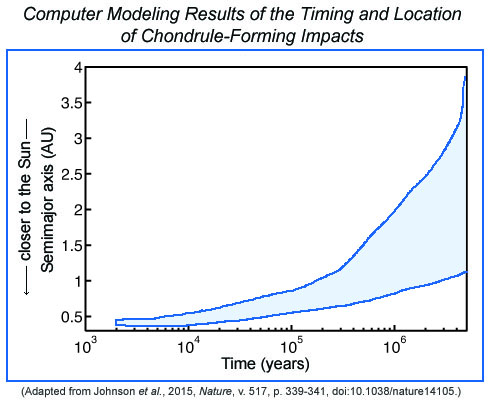 |
| Simplified diagram showing the timing of chondrule-forming impacts versus the semi-major axis (distance from the Sun–an indication of stirring of the collection of growing bodies orbiting the Sun early in the history of the Solar System). The case shown assumed that the initial total mass of the dust cloud surrounding the Sun was triple what we can estimate from the current set of objects in the Solar System. This allows for significant loss during accretion and loss of the nebular gas. Chondrule formation could start as early as a thousand years after the Solar System began to form, but the amount of mass jetted from impacts increases dramatically with time, as shown by the width between the curves. Most chondrules would form between 1 and 4 million years after formation of calcium-aluminum-rich inclusions (CAIs), which is consistent with measurements of chondrule ages. Impacts continue to happen, of course, but the nebular gas is thought to dissipate in a few million years, which prevents chondrules from slowing down enough to accrete. Even more encouraging, the time estimate may allow for some chondrules to form at the same time as CAIs. |
Chondrule abundances: Lon Hood (University of Arizona) and Stu Weidenschilling (Planetary Sciences Institute, Tucson) calculated in a 2012 paper that chondritic bodies in the asteroid belt contained 3 to 30 times the mass of asteroids in the main belt. Brandon Johnson and colleagues calculate that for the case of a solar nebula three times larger than the minimum nebula, the total mass of chondrules produced by jetting as big planetesimals collided was on the order of 11 times the mass of the asteroid belt, compared to the 3 to 30 times calculated by Hood and Weidenschilling. The minimum solar nebula mass does not make enough chondrules. A central uncertainty is the efficiency of chondrule accretion. Nevertheless, considering that we are dealing with orders of magnitude, the abundances may not be a show stopper.
Chondrule sizes: In the jetting model, chondrule sizes are governed by the interplay of fragmentation due to pressure release after the jet forms. The size of the droplets is determined by differential motions inside the molten globs and their strength (called surface tension). Brandon Johnson estimated that the maximum chondrule sizes would be in the range of a few tenths to a few millimeters in size, not too much different from chondrules, especially if you allow for some aerodynamic sorting as chondrules traveled through the nebular gas before accreting to a fledgling asteroid.
Cooling rates: Estimating the cooling rates of millimeter-sized droplets in impact jets requires some assumptions, but Johnson and colleagues suggest that chondrules will cool at 10 to 1000 Kelvin per hour. This is in reasonable agreement with cooling rates estimated from chondrule observations and crystallization experiments, 5 to 3000 Kelvin per hour.
Chondrule compositions: Like most models for chondrule origin, the impact jetting idea has trouble accounting for the diverse range in chondrule compositions. Johnson and coworkers recognize the problem, even pointing out that the jetting process would seem to encourage mixing and homogenization. They suggest that it is likely the impacting planetesimals had different compositions, implying that the jetted melt-vapor mix would have been chemically diverse. They also suggest that the compositional differences between impacting objects changed with time. However, the otherwise quantitative assessment by Johnson and colleagues does not account for the huge compositional diversity of chondrules and the presence of practically the full range of compositions in each chondrite group.
And the Argument Goes On...
Brandon Johnson and his colleagues have added another entry into the chondrule sweepstakes. This entry, along with those by Melissa Morris and coworkers and Lon Hood and Stu Weidenschilling look at chondrules "not as the direct building blocks of the planets, but merely a byproduct of their accretion," as Johnson and coworkers write. Team Johnson, however, propose a pure planetary-accretion model. The bow-shock hypotheses of Morris and Hood assume the presence of chondrule precursor dust balls. Thus, collectively, hypotheses for chondrule origin span the range of purely nebular processes to purely planetary accretional processes, and everything in between. Considering the range in chondrule properties, especially their ages and compositions, maybe they formed in many ways. Maybe all roads lead to Rome.
- PSRDpresents: Ancient Jets of Fiery Rain--Short Slide Summary (with accompanying notes).
- Connelly, J. N., Bizzarro, M., Krot, A. N., Nordlund, Å., Wielandt, D., and Ivanova, M. A. (2012) The Absolute Chronology and Thermal Processing of Solids in the Solar Protoplanetary Disk, Science, v. 338, p. 651-655, doi: 10.1126/science.1226919. [ abstract ]
- Hewins, R. H., Connolly, H. C., Lofgren, G. E., Jr., Libourel, G. (2005) Experimental Constraints on Chondrule Formation. In Chondrites and the Protoplanetary Disk, ASP Conference Series, v . 341, Proceedings of a workshop held 8-11 November 2004 in Kaua‘i, Hawai‘i. Edited by Alexander N. Krot, Edward R. D. Scott, and Bo Reipurth. Astronomical Society of the Pacific, San Francisco, p.286. [ abstract ]
- Hood, L. L. and Weidenschilling, S. J. (2012) The Planetesimal Bow Shock Model for Chondrule Formation: A More Quantitatively Assessment of the Standard (Fixed Jupiter) Case, Meteoritics & Planetary Science, v. 47, p. 1715-1727, doi:10.1111/maps.12006. [ abstract ]
- Johnson, B. C., Bowling, T. J., and Melosh, H. J. (2014) Jetting During Vertical Impacts of Spherical Projectiles, Icarus, v. 238, p. 13-22, doi:10.1016/j.icarus.2014.05.003. [ abstract ]
- Johnson, B. C., Minton, D. A., Melosh, H. J., and Zuber, M. T. (2015) Impact Jetting as the Origin of Chondrules, Nature, v. 517, p. 339-341, doi:10.1038/nature14105. [ abstract ]
- Morris, M. A., Boley, A. C., Desch, S. J., Athanassiadou, T. (2012) Chondrule Formation in Bow Shocks Around Eccentric Planetary Embryos, Astrophysical Journal, v. 752:27, doi:10.1088/0004-637X/752/1/27. [ abstract ]
- Taylor, G. J., Scott, E. R. D. and Keil, K. (1983) Cosmic Setting for Chondrule Formation. In Chondrules and Their Origins. Edited by E.A. King. p. 262-278. Lunar and Planetary Institute, Houston. [ abstract ]
- Wood, J. A. (1963) On the Origin of Chondrules and Chondrites, Icarus, v. 2, p. 152-180, doi:10.1016/0019-1035(63)90013-7. [ abstract ]
|
|
[ About PSRD | Archive | CosmoSparks | Search | Subscribe ] [ Glossary | General Resources | Comments | Top of page ] |


